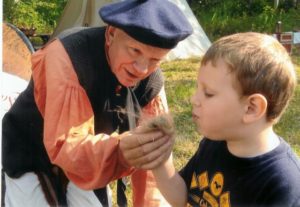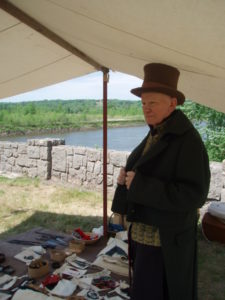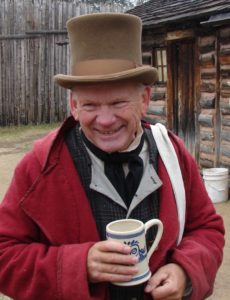
The old voyageur and a young scout. Photo courtesy of La Compagnie archives
This is the last of Tom Brennan’s “ramblings,” part 3 of 3. “How wonderful it is to be a part of this effort,” he says. How wonderful that we knew Tom. How wonderful that he shared so much of himself. We miss him and his wonderful spirit at every event and on every canoe trip with every swing of our paddles.
So how else should we do this thing? Most importantly, we should worry about “them.”
Help the visitor get into the spirit: Most visitors are not familiar with the kind of interpretation that we do and may feel confused as to how to interact with us. Here a simple invitation to join us at the site or display is in order. Greet them as they draw near and say that it is permissible to visit and ask questions.
If something seems to attract their interest, say the canoe, invite them into conversation with a question, “What do you think of that canoe—isn’t she a beauty?” Such a gentle invitation does not force them into a teaching moment but allows them to step in if they wish.
Another way that invites is to practice a special skill—finger weaving, sewing, canoe repair, etc. As the visitor passes by, a simple statement of what you are doing could initiate a longer conversation on something you are ready to explain from your own experience.

Fur trader Tom Brennan with a display of trade goods, The Landing, May 2009. Photo courtesy Nancy Powell
Use the display items to tell stories: Often we are tempted to emphasize our knowledge about the items on the blanket rather than invite the visitor to be a part of the display’s story. What This Awl Means: Feminist Archaeology at a Wahpeton Dakota Village (Janet D. Spector) is a great example of a type of story telling that we, too, can use.
For example, a simple tool, an awl, starts a conversation about the importance of everyday things in people’s lives. A fire steel and the spark we just made or helped the visitor to make can lead to stories about fire for survival, cooking techniques, and preferred utensils. Compare a metal pot to clay or birch bark.
I find having people try to guess the purpose of the item wastes too much time that could be spent on telling the stories and meanings in the artifact and may make them uncomfortable in the process.
Play with the child: In a very real sense there is a childlike quality that must come into play when we interpret. We are playing a game with history. If we can connect with the “inner child” in the visitor, the interpretation will flow much better.
If children are present, interacting with them attracts the adults as well. Parents always seem to beam when you involve their child as a participant, and the reluctant child may come alive to the experience. To have a child put on a sash, or hold a paddle, or help decide what would be important enough to trade for a fur usually enlightens adults too. The same technique can work with adults also.
I like to keep my conversation on the light side to spur interaction. Pretend to trade for silver with the women or convince the men that if they bring home that expensive musket, they better bring something for the rest of the family too. The playful approach often leads to deeper discussion,
Know when to quit: Over my years, I have had to learn how much information is enough and how much is too much to share. I always want to know more than I tell the visitors. If they respond in a way that suggests interest, I can walk further with them. Then I remind myself that I cannot know everything.
When I began interpreting, I was tempted to make up answers to questions. I’ve learned that it’s better to indicate that I do not know, ask another interpreter who might have that information, and then go to work to fill in that blank in my knowledge.

Spring Thaw training, 2008. Photo courtesy of Ron Engh
Do no harm: For me, the last thing I want to happen is for a visitor to be embarrassed by an interpreter. Of course, the interpreter supposedly is the expert, but visitors rarely expect to have their ignorance exposed when they visit a historic site.
One of the ways that has worked for me to keep from embarrassing a visitor is the use the interpretation technique of “my time/your time.”
I can speak to them as a person who lives in the strange time that they have stumbled upon, but I also indicate that I understand another time, their time. We can then make comparisons.
We need not try to involve our listeners in first person conversation in a time period of which they know very little. Acknowledge modern time, then lead them, without arrogance, to explore with us this wonderful time in which we “live.“
We are all volunteers doing the best we can. If at the end of the day, we have awakened memories in a visitor, inspired interest in studying more history for a school child or simply introduced someone to a small segment of history and have had fun doing it, have we not done our job?
The discussion of what and how to interpret will continue as long as there are people interested in telling stories, and interpretative styles will evolve as well. In the end the goal is to bring history alive in a way that will help us understand our lives today. How wonderful it is to be a part of this effort.

